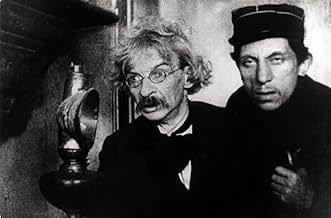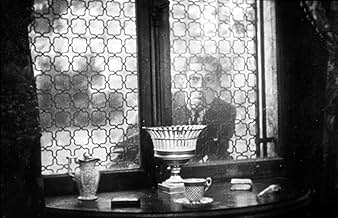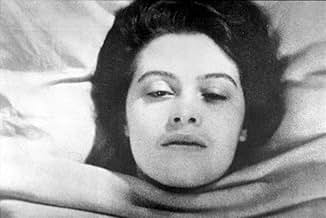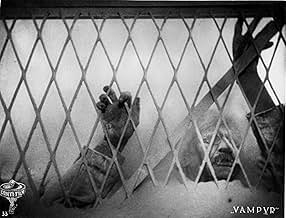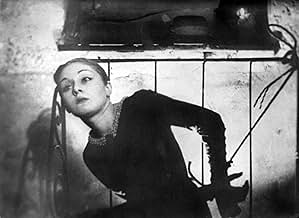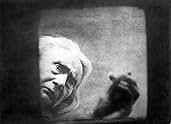IMDb रेटिंग
7.4/10
22 हज़ार
आपकी रेटिंग
अमानुषी तथ्यों का जुनूनी एक आवारा, एक सराय में आता है, जहां एक गंभीर रूप से बीमार किशोरी धीरे-धीरे एक पिशाच बन रही है.अमानुषी तथ्यों का जुनूनी एक आवारा, एक सराय में आता है, जहां एक गंभीर रूप से बीमार किशोरी धीरे-धीरे एक पिशाच बन रही है.अमानुषी तथ्यों का जुनूनी एक आवारा, एक सराय में आता है, जहां एक गंभीर रूप से बीमार किशोरी धीरे-धीरे एक पिशाच बन रही है.
- निर्देशक
- लेखक
- स्टार
- पुरस्कार
- कुल 1 जीत
Henriette Gérard
- Die alte Frau vom Friedhof (The Old Woman from the Cemetery)
- (as Henriette Gérard)
Kani Kipçak
- Michael
- (बिना क्रेडिट के)
फ़ीचर्ड समीक्षाएं
The major figure of Carl Theodor Dreyer is one of a select group of directors deemed 'transcendental' along with the likes of Ozu and Bresson. Paul Schrader and other critics identify them as those filmmakers who habitually suggest spiritual intensity by ordinary means. Characteristically austere, often using non-professional talent in their films, they find universal truths through a gradual un-dramatic revelation of interior life. All this means in this context is that one would think such directors far away from the flashy supernaturalism and ghastly melodrama normally making up so much of the traditional horror film, a genre where its the extraordinary providing the revelation for the audience, not the mundane. But then one remembers that both Dreyer and Bresson made memorable versions of Joan of Arc, where their representing of terrifying events showed how disturbing an emotionally stark and restrained approach could prove. And, in 1932, about as the first great Universal horror cycle was getting into its stride in Hollywood, Dreyer made his Vampyr.
It is interesting to compare Dreyer's great work with that of Murnau, the only other great director who made a broadly comparable title. Both the German director and the Dane took their inspiration from literary horror classics. Murnau based his Nosferatu (1922) on Dracula while, for his inspiration, Dreyer too turned to an English author: Sheridan le Fanu and his novel Carmilla. But the evil thrill of Nosferatu is that it takes place in a concrete 'reality' of sorts, ghostly special effects notwithstanding. By contrast Vampyr is a strange, dreamlike film, one virtually silent or subdued, despite its soundtrack. Moreover it mainly exists in variable prints, the poor state of which merely adds to the strange dislocatedness of unfolding events portrayed. Dreyer's terror lies in a world of shadows, surreality amplified by some remarkable cinematography, the roots of nightmare ever subtle, where camera movement can excite as much dread and anticipation as any vampire out clawing at a victim.
Vampyr's story, such as it is, tells of Allan Grey (Julian West), a man studious of vampires. In a small French town, he takes a room at an inn. His sleep is interrupted when a strange man (Maurice Shutz) comes into his room speaking disturbingly about death, then leaves a small package with instructions that it should be opened upon his death. Allen gets out of bed, and prowls around the inn and its spooky surroundings in search of an explanation. Eventually he wanders onto a nearby estate where he finds the mysterious man living with his two daughters. A vampire has bitten one of his daughters, and the house is shrouded in death...
Once seen and felt, the peculiarly eerie atmosphere that characterises Dreyer's work is never forgotten. Indeed, Vampyr's influence arguably began at once, for a similar tone of silent mystery pervades some scenes in White Zombie, incidentally one of Bela Lugosi's best, made just the same year - another film which made in sound which often plays like a silent. Like Vampyr, White Zombie includes several wordless sequences which are startlingly eerie and atmospheric. (Both this and present film are much better than Tod Browning's famous version of Dracula also made at about the same time, which these days seem positively wooden by comparison.) And, years later, Ken Russell was to mimic the premature burial sequence of Vampyr, glass windowed coffin and all, in his uneven Mahler while arguably a similar, dreamlike, touch can be found in the work of the French horror auteur Jean Rollin, who in the 1970s made of soft tinted vampirism almost a genre of its own.
Of his original film Dreyer said, "I wanted to create the daydream on film to show that horror is not a part of the things around us, but of our own subconscious mind." To help achieve this, he and his cameraman Rudolph Mate shot much very early in the morning and frequently through fine gauze - a creative decision increasing the sense of mystery surrounding events. The resultant shimmer and softness which fell over scenes suggests the supernatural confusion felt by the hero, and add a spooky disconnectedness to events. Allied to this, as already noted, this is a work where one is acutely aware of camera placement and movement, of shadow and light. Dreyer's sensitive direction means that the lens becomes a lurking accompaniment to Grey's, and therefore our, unease.
Main actor Julian West, who also financed a lot of the picture, makes a suitable impression; part of the mood in what is his only significant film. Forty years later he again appeared again on screen, but with less impact. In retrospect nothing could compare to his appearance here, his pale, Lovecraftian features perfectly in tune with the gloomy goings on. His anonymous freshness as an actor makes of him an everyman, a dramatic unknown fitting in exactly with the director's preferred casting with the undemonstrative and normal. And unlike Nosferatu's celebrated settings of castles, doom laden ships and spectral carriages, Vampyr's unease is primarily set amidst the domestic: an inn, a to-do private home or in common place out-buildings.
Dismayed by distracting subtitles, often faded visuals and poor soundtrack elements, admirers of Dreyer's masterpiece have long cried out in vain for a restored version, especially now that the later films of the director have been reissued. Even such earlier silents such as the lesser, decidedly more obscure, Master Of The House (1925) have lately arrived with a five star treatment on disc. Whether or not this lapse is due to a fatal absence of original materials I am not sure, but fans of one of the very finest horror films, and a rare one by a great director to boot, will not be satisfied until this Vampyr at least is resurrected and given the new life it deserves.
It is interesting to compare Dreyer's great work with that of Murnau, the only other great director who made a broadly comparable title. Both the German director and the Dane took their inspiration from literary horror classics. Murnau based his Nosferatu (1922) on Dracula while, for his inspiration, Dreyer too turned to an English author: Sheridan le Fanu and his novel Carmilla. But the evil thrill of Nosferatu is that it takes place in a concrete 'reality' of sorts, ghostly special effects notwithstanding. By contrast Vampyr is a strange, dreamlike film, one virtually silent or subdued, despite its soundtrack. Moreover it mainly exists in variable prints, the poor state of which merely adds to the strange dislocatedness of unfolding events portrayed. Dreyer's terror lies in a world of shadows, surreality amplified by some remarkable cinematography, the roots of nightmare ever subtle, where camera movement can excite as much dread and anticipation as any vampire out clawing at a victim.
Vampyr's story, such as it is, tells of Allan Grey (Julian West), a man studious of vampires. In a small French town, he takes a room at an inn. His sleep is interrupted when a strange man (Maurice Shutz) comes into his room speaking disturbingly about death, then leaves a small package with instructions that it should be opened upon his death. Allen gets out of bed, and prowls around the inn and its spooky surroundings in search of an explanation. Eventually he wanders onto a nearby estate where he finds the mysterious man living with his two daughters. A vampire has bitten one of his daughters, and the house is shrouded in death...
Once seen and felt, the peculiarly eerie atmosphere that characterises Dreyer's work is never forgotten. Indeed, Vampyr's influence arguably began at once, for a similar tone of silent mystery pervades some scenes in White Zombie, incidentally one of Bela Lugosi's best, made just the same year - another film which made in sound which often plays like a silent. Like Vampyr, White Zombie includes several wordless sequences which are startlingly eerie and atmospheric. (Both this and present film are much better than Tod Browning's famous version of Dracula also made at about the same time, which these days seem positively wooden by comparison.) And, years later, Ken Russell was to mimic the premature burial sequence of Vampyr, glass windowed coffin and all, in his uneven Mahler while arguably a similar, dreamlike, touch can be found in the work of the French horror auteur Jean Rollin, who in the 1970s made of soft tinted vampirism almost a genre of its own.
Of his original film Dreyer said, "I wanted to create the daydream on film to show that horror is not a part of the things around us, but of our own subconscious mind." To help achieve this, he and his cameraman Rudolph Mate shot much very early in the morning and frequently through fine gauze - a creative decision increasing the sense of mystery surrounding events. The resultant shimmer and softness which fell over scenes suggests the supernatural confusion felt by the hero, and add a spooky disconnectedness to events. Allied to this, as already noted, this is a work where one is acutely aware of camera placement and movement, of shadow and light. Dreyer's sensitive direction means that the lens becomes a lurking accompaniment to Grey's, and therefore our, unease.
Main actor Julian West, who also financed a lot of the picture, makes a suitable impression; part of the mood in what is his only significant film. Forty years later he again appeared again on screen, but with less impact. In retrospect nothing could compare to his appearance here, his pale, Lovecraftian features perfectly in tune with the gloomy goings on. His anonymous freshness as an actor makes of him an everyman, a dramatic unknown fitting in exactly with the director's preferred casting with the undemonstrative and normal. And unlike Nosferatu's celebrated settings of castles, doom laden ships and spectral carriages, Vampyr's unease is primarily set amidst the domestic: an inn, a to-do private home or in common place out-buildings.
Dismayed by distracting subtitles, often faded visuals and poor soundtrack elements, admirers of Dreyer's masterpiece have long cried out in vain for a restored version, especially now that the later films of the director have been reissued. Even such earlier silents such as the lesser, decidedly more obscure, Master Of The House (1925) have lately arrived with a five star treatment on disc. Whether or not this lapse is due to a fatal absence of original materials I am not sure, but fans of one of the very finest horror films, and a rare one by a great director to boot, will not be satisfied until this Vampyr at least is resurrected and given the new life it deserves.
"Vampyr", one of the first horror movies with sound, is the work of the highly influential danish director Carl Theodor Dreyer. After directing the monumental "La Passion de Jeanne d'Arc" in 1928, Dreyer decided to make this modest film based on the novel "In a Glass Darkly" by Sheridan Le Fanu; while this is indeed his first movie with sound, it was conceived as a silent film, and the movie contains very few dialog.
I must admit that as many, I was left with a big question mark in my face as the story was progressing; but the apparently disjointed storyline do make sense, as it is worked as a surreal experience of the lead character, it is as if Dreyer had filmed a nightmare, complete with the haunting images and eerie atmosphere.
The movie is about a traveler, named Allan Grey (Julian West), who gets involved in a nightmarish plot when the owner of the inn where he is staying asks him for help to save his family from what he believes is a vampire. We follow Allan Grey in his surrealistic trip to madness as he finds out more and more about the supposed vampire that haunts the manor turned inn.
The highly inventive camera work is truly outstanding, the combination of light and darkness is among the finest work in a black & white film and alone makes the movie worth a look; the movie not only has the structure of a nightmare, it also looks like one. The Gothic manor and the lonely rural exteriors increase the haunting atmosphere and the beautiful images Dreyer conceived are the work of a genius.
The structure of the script may be complicated, but it shows its influence over David Lynch and other filmmakers with similar surrealist story lines and dreamlike sequences. It is probably not a masterpiece of the likes of the aforementioned "Passion" or the more well-known "Day of Wrath" (Vredens dag, 1943), but "Vampyr" shines with its own light as one of the finest horror movies of that period.
The only real flaw in my opinion, was that the lead actor, Julian West, was probably not the best choice for a lead role, as his acting seems unnatural and not believable. I'm not sure if this was intended that way or had more to do with the fact that West produced the film, but it is my only complain about "Vampyr".
This modest masterpiece is a must see for any horror fan or anyone who likes silent movies. It is a nightmarish trip to the darker parts of the subconscious mind. 8/10
I must admit that as many, I was left with a big question mark in my face as the story was progressing; but the apparently disjointed storyline do make sense, as it is worked as a surreal experience of the lead character, it is as if Dreyer had filmed a nightmare, complete with the haunting images and eerie atmosphere.
The movie is about a traveler, named Allan Grey (Julian West), who gets involved in a nightmarish plot when the owner of the inn where he is staying asks him for help to save his family from what he believes is a vampire. We follow Allan Grey in his surrealistic trip to madness as he finds out more and more about the supposed vampire that haunts the manor turned inn.
The highly inventive camera work is truly outstanding, the combination of light and darkness is among the finest work in a black & white film and alone makes the movie worth a look; the movie not only has the structure of a nightmare, it also looks like one. The Gothic manor and the lonely rural exteriors increase the haunting atmosphere and the beautiful images Dreyer conceived are the work of a genius.
The structure of the script may be complicated, but it shows its influence over David Lynch and other filmmakers with similar surrealist story lines and dreamlike sequences. It is probably not a masterpiece of the likes of the aforementioned "Passion" or the more well-known "Day of Wrath" (Vredens dag, 1943), but "Vampyr" shines with its own light as one of the finest horror movies of that period.
The only real flaw in my opinion, was that the lead actor, Julian West, was probably not the best choice for a lead role, as his acting seems unnatural and not believable. I'm not sure if this was intended that way or had more to do with the fact that West produced the film, but it is my only complain about "Vampyr".
This modest masterpiece is a must see for any horror fan or anyone who likes silent movies. It is a nightmarish trip to the darker parts of the subconscious mind. 8/10
Since I was a kid interested in foreign and older films, I've been haunted by this picture. I remember seeing a shot of the back of a woman's head. She slowly turns around to reveal black lips, darkened eyes, and a smile of someone possessed of the vampire spirit.
Later, in school, I had the pleasure of seeing more of Dreyer's work. He didn't make any more 'horror pictures' to my knowledge, but everything else I saw had the same brooding, eerie sense, the same lack of interest in a driving plot, and the same photographic expertise that kept me enthralled when I first saw this picture.
He's considered one of the masters. He's not to everyone's taste. But, with VAMPYR, he got to me before I ever learned how to say the word 'cinema.'
Later, in school, I had the pleasure of seeing more of Dreyer's work. He didn't make any more 'horror pictures' to my knowledge, but everything else I saw had the same brooding, eerie sense, the same lack of interest in a driving plot, and the same photographic expertise that kept me enthralled when I first saw this picture.
He's considered one of the masters. He's not to everyone's taste. But, with VAMPYR, he got to me before I ever learned how to say the word 'cinema.'
For a movie made in 1932, this is very, very impressive. Confusing plot aside, the emphasis in this Victorian nightmare is placed on the cinematic aspects. "Vampyr" is plodding, very dark and eerie, filled with such haunting atmosphere and brooding visuals full of unseen, but lurking terror - very effecting. It works on a subconscious and emotional level more than any other way. I think it's worth a look.
With its fragmented plot, eerie imagery, and air of undefined menace this film more nearly realises the dream state than any other film I've seen.
The story, which follows a young man's discovery of vampiric doings while on a trip to the country, is secondary to the fascinatingly uncanny mood generated by the cinematography and effective use of sound and silence.
Yes, yes, it's old and unconventional, and requires either some extra concentration or complete surrender to its unique world, but the effort is worth it.
Vampyr should especially appeal to fans of cinefantastique, cinema history and maybe even the arthouse crowd.
The story, which follows a young man's discovery of vampiric doings while on a trip to the country, is secondary to the fascinatingly uncanny mood generated by the cinematography and effective use of sound and silence.
Yes, yes, it's old and unconventional, and requires either some extra concentration or complete surrender to its unique world, but the effort is worth it.
Vampyr should especially appeal to fans of cinefantastique, cinema history and maybe even the arthouse crowd.
क्या आपको पता है
- ट्रिवियाFor much of the cast, this was their only film appearance, since they were not professional actors. Henriette Gérard, who played the vampire, was a French widow, Jan Hieronimko, who played the village doctor, was a Polish journalist, and Rena Mandel, who played Gisèle, was an artist's model. Julian West (real name: Baron Nicolas de Gunzburg), who played Allan Grey, was a French-born member of Russian nobility who agreed to finance the film in exchange for the leading part. (He later emigrated to America where he became a powerful fashion journalist and mentor to designers like Calvin Klein.)
- गूफ़At exactly 16 minutes (in the Criterion DVD) as the camera pans right, there is a reflection in a glass window of the camera operator cranking the camera.
- इसके अलावा अन्य वर्जनThere is an Italian edition of this film on DVD, distributed by DNA srl, "LA STRANA AVVENTURA DI DAVID GRAY (Vampyr - Il vampiro, 1932) + NOSFERATU, UNA SINFONIA DELL'ORRORE (1922)" (2 Films on a single DVD), re-edited with the contribution of film historian Riccardo Cusin. This version is also available for streaming on some platforms.
- कनेक्शनEdited into Dr. Terror's House of Horrors (1943)
टॉप पसंद
रेटिंग देने के लिए साइन-इन करें और वैयक्तिकृत सुझावों के लिए वॉचलिस्ट करें
- How long is Vampyr?Alexa द्वारा संचालित
विवरण
- रिलीज़ की तारीख़
- कंट्री ऑफ़ ओरिजिन
- भाषाएं
- इस रूप में भी जाना जाता है
- Castle of Doom
- फ़िल्माने की जगहें
- Abbaye de Braye, Braye, Aisne, फ़्रांस(recreated cemetery)
- उत्पादन कंपनी
- IMDbPro पर और कंपनी क्रेडिट देखें
- चलने की अवधि1 घंटा 15 मिनट
- रंग
- पक्ष अनुपात
- 1.19 : 1
इस पेज में योगदान दें
किसी बदलाव का सुझाव दें या अनुपलब्ध कॉन्टेंट जोड़ें





